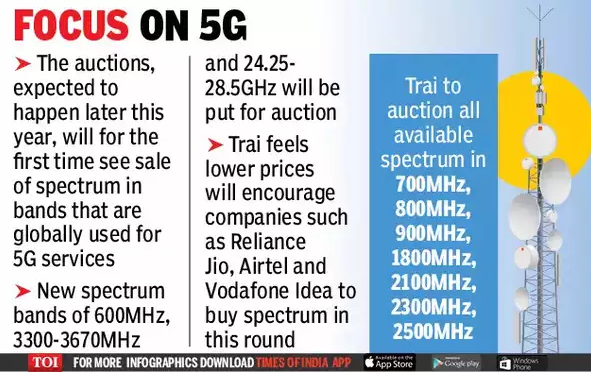Description

Disclaimer: Copyright infringement not intended.
Context
Context
- 5G represents the allocation of new spectrum to increase capacity. Since most of the spectrum at lower frequencies is already being utilised — much of this new spectrum is being allocated at higher frequencies.
What is Spectrum?
- Spectrum refers to the invisible radio frequencies that wireless signals travel over. Those signals are what enable us to make calls from our mobile devices, tag our friends on Instagram, call an Uber, pull up directions to a destination, and do everything on our mobile devices.
- The frequencies we use for wireless are only a portion of what is called the electromagnetic spectrum.
- Note: The electromagnetic spectrum includes everything from infrared rays to radio waves, X-Rays, visible light, microwaves and more.
- Portions of electromagnetic spectrum are grouped in “bands” depending on their wavelengths—the distance over which the wave’s shape repeats. The full electromagnetic spectrum ranges from three Hz (extremely low frequency) to 300 EHz (gamma rays).
- Cellular technology operates upon the radio spectrum (not visible), which includes frequencies of 3 kilohertz (kHz) to 300 gigahertz (GHz).
- Other parts of spectrum carry broadcast radio and television or serve other everyday functions.
How does Spectrum work?
- Because a range of spectrum frequencies can be used for cellular communications, different bands have slightly different characteristics.
- For the purposes of wireless communication, we can think of spectrum in three categories: low-, mid-, and high-band spectrum.
- Low-band spectrum (under 3 GHz) travels longer distances with minimal signal interruption. Today’s wireless networks are built primarily on low-band spectrum, and the wireless industry has used this spectrum to build high-speed wireless networks that cover 99.7 percent of Americans.
- High-band spectrum (above 24 GHz) travels much shorter distances—think meters, not miles—compared to low-band spectrum, but offers high capacity and ultra-fast speeds.
- Mid-band spectrum (between 3 and 24 GHz) blends the characteristics of both low- and high-band spectrum—providing a mix of coverage and capacity.
These spectrum frequencies are transmitted between cell sites and our mobile devices.
5G Airwaves
- The 5G spectrum includes all type of spectrum including low band and mid band spectrum of the 1G through 4G LTE frequencies as well as the new high-band spectrum, also known as millimeter wavelength (mmWave).
- The 5G spectrum is a range of radio frequencies in the sub-6 GHz range and the millimeter-wave (mmWave) frequency range that is 24.25 GHz and above.
- In a nutshell, 5G will bring wider bandwidths by expanding the usage of spectrum resources, from sub-3 GHz used in 4G to 100 GHz and beyond. 5G can operate in both lower bands (e.g., sub-6 GHz) as well as mmWave (e.g., 24 GHz and up), which will bring extreme capacity, multi-Gbps throughput, and low latency.
Must Read: https://www.iasgyan.in/blogs/the-evolution-of-5g-technology
https://www.iasgyan.in/daily-current-affairs/5g-2
https://www.iasgyan.in/blogs/5g-technology-a-primer
5G and Technology
- Radio electronics refers to a broad range of technologies that can transmit, receive and process wireless signals.
- While these technologies can utilise electromagnetic spectrum that goes all the way up to 300GHz, the lower frequencies of this spectrum are particularly attractive.
- Lower frequency signals can travel longer distances and penetrate obstacles with lesser attenuation.
- Electronic components (amplifiers, transmitters, receivers) operating at lower frequencies are also easier to design and manufacture. Consequently, much of the bandwidth in the lower frequencies of this spectrum has already been allocated for several applications (mobile communications currently use the spectrum from 800MHz to 2.5 GHz).
New spectrum for 3GHz
- With the increasing demand for mobile services, the currently allocated spectrum is proving inadequate.
- At the simplest level, 5G represents the allocation of new spectrum to increase capacity. Since most of the spectrum at lower frequencies is already being utilised — much of this new spectrum is being allocated at higher frequencies.
- The first deployments in India will be around 3GHz, but will expand to 25 GHz and beyond.
- As 5G services evolve to occupy higher frequencies, it will significantly increase the bandwidth available for mobile services. However, at these frequencies the design of the transmitting and receiving equipment becomes more complex.
- Signal attenuation also increases. So, the coverage area of each cell tower will decrease which will require the towers to be more closely spaced.
- At higher frequencies it becomes easier to direct a signal in specific direction. So, signals transmitted from a cell tower can be more precisely directed at a specific user (rather than spreading out in various directions which is just a waste of energy).
- This enhanced directivity results in less interference between signals meant for different users which directly translates to increased capacity. Thus, while operating at higher frequencies has some fundamental challenges, it offers some unique opportunities as well.
Evolving communication needs
- 5G places special emphasis on low latency, energy efficiency and standardisation.
- Existing wireless communication infrastructure is primarily designed around the needs of mobile phones. However, several emerging applications in factory automation, gaming and remote healthcare have more stringent latency requirements.
- Self-driving cars is an illustrative example. Low delays between transmission and reception of messages are extremely critical when these cars have to co-operate with each other to avoid accidents.
- As 5G rolls out, over the next several years the volume of data is expected to exponentially increase.
- To ensure that there isn’t a corresponding increase in the energy usage, 5G places a lot of importance on energy efficiency.
- This will mean lower energy bills for service providers and longer battery life for mobile devices.
- Greater attention to standardisation is another important aspect of 5G.
- Today most of the components that make up wireless telecom interact with each other using proprietary protocols that are vendor specific.
- To enable the rapid deployment of 5G infrastructure there is an industry-wide effort to standardise interaction between components.
- Greater standardisation would enable service providers to build their infrastructure, ‘mixing and matching’ components from multiple vendors. Switching vendors would also be easier which would foster competition and lower costs.
Concerns pertaining to Spectrum affordability
- Telecom companies had pointed out that the reserve price of the airwaves is very high.
- Telecom industry body Cellular Operators Association of India (COAI) had also expressed concerns about the financial health of the sector amid intense competition and recent phase of consolidation.
- The COAI had pointed out that 5G is overpriced by at least 30% to 40% compared to international standards and auction in other markets such as South Korea and the U.S.
Recent suggestions made by TRAI
- All available spectrum in the existing bands of 700 MHz, 800 MHz, 900 MHz, 1800 MHz, 2100 MHz, 2300 MHz, 2500 MHz as well as the newer frequency bands of 600 MHz, 3300-3670 MHz, and 24.25-28.5 GHz also be put up for auction in India.
- TRAI has also suggested that telecom service providers should be allowed to surrender spectrum easily by paying a spectrum surrender fee of Rs 1 lakh per spectrum band per Licenced Service Area (LSA).
- TRAI has suggested easing some of the minimum roll out (MRO) obligations for deployment of 5G by the new entrants in the telecom sector. For example, in the 700 MHz, 800 MHz, 900 MHz, and 1800 MHz bands, Trai has suggested that the time period for MRO should be extended to 2 years from 1 year currently.
- For the auction of the 5G spectrum, the telecom regulatory body suggested that the base price for prime 5G band of 3300-3670 MHz be kept at Rs 317 crore per MHz, which is 35 per cent lower than the base price of Rs 492 crore per MHz announced in 2018.
- Similarly, for the 700 MHz, the price recommended by Trai comes out to Rs 3,297 crore, which is almost 40 per cent lower than prices recommended by the regulatory in 2018.
- The reserve prices, however, will be for a period of 20 years. In case the spectrum is allocated for a period of 30 years, the base price to be considered should be 1.5 times the price recommended for the 20 year period.

Implications
- Lowering of the base price for 5G airwaves in the auction will spur participation by local telecom firms and expedite the rollout of these superfast networks.
- For the long-term growth and sustainability of the telecom sector, infusing liquidity and encouraging investment, the telecom service providers should be allowed easy payment options including part payment with flexibility of moratorium.
Final Thoughts
- 5G technology has significant transformative potential for the Indian economy.
- To unlock that potential, the Indian government must encourage investment in the form of timely and affordable spectrum.
- Widespread high-quality networks maximise access to mobile broadband services for a lower cost to users, including enterprises, which, in turn, drive a significant impact on the digital and the overall economy.
https://epaper.thehindu.com/Home/MShareArticle?OrgId=G9P9S7KQI.1&imageview=0
1.png)












